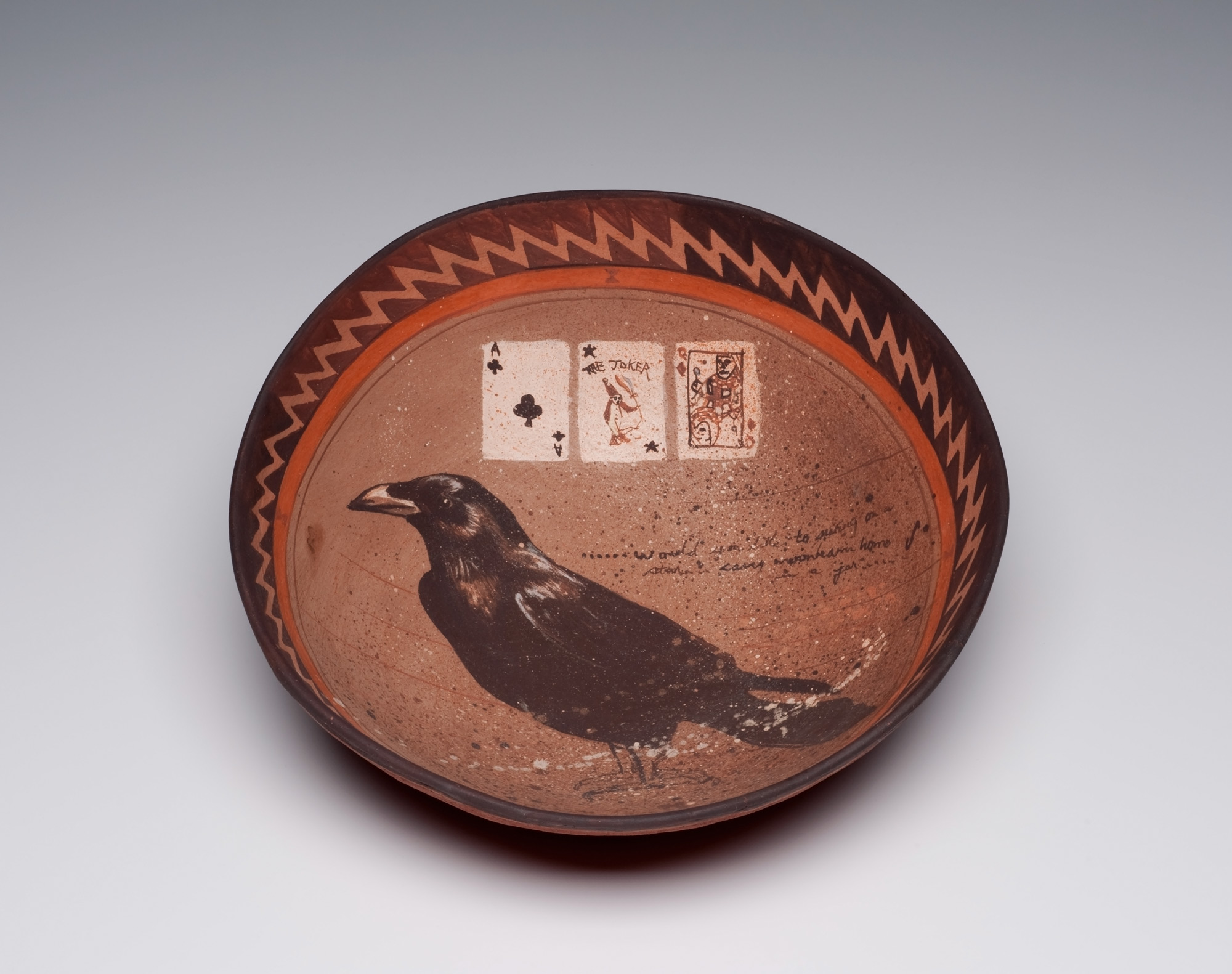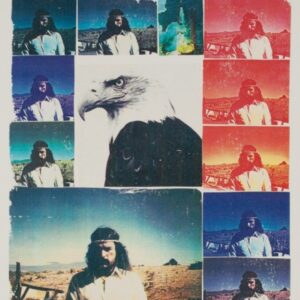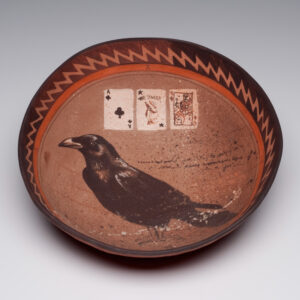Raven 1983

Carl Beam, Raven, 1983
Natural mineral pigment on unglazed earthenware, 13.4 x 34.8 cm
Canadian Museum of History, Gatineau
© Estate of Carl and Ann Beam / CARCC Ottawa 2024
In Raven, collaged images of a raven and three playing cards are encircled by a border that references design motifs found on earthenware vessels made by the Mimbres, an ancient people of southwestern New Mexico. The bowl was crafted using traditional materials and hand-built (not thrown or wheel-turned) methods. It is a significant example of Carl Beam’s innovation with ceramics, illustrating his proficiency with different media and the interrelated nature of his creative practice. Beam’s ceramics combines several methods, techniques, and modes of representation, juxtaposing seemingly unrelated and cross-cultural imagery in a manner like that used in his painted compositions—using photo-emulsion transfers, decals, and painted symbols and handwritten texts.
-
Ann holding Anong Migwans Beam at a prayer well in New Mexico, 1980, photograph by Carl Beam
© Estate of Carl and Ann Beam / CARCC Ottawa 2024
-
Carl and Ann Beam’s ceramic wares, n.d., photograph by Carl Beam
© Estate of Carl and Ann Beam / CARCC Ottawa 2024 -
Carl Beam, Opus Nova, 1983
Natural mineral pigment on unglazed earthenware, 13 x 35.5 cm
Canadian Museum of History, Gatineau
© Estate of Carl and Ann Beam / CARCC Ottawa 2024
Though Beam studied ceramics at the University of Victoria with Frances Maria Hatfield (1924–2014), the practice did not immediately resonate with him. “The training was excellent,” he later explained, “but I always had a feeling that I couldn’t articulate what I wanted in the medium of clay. I was experimental and bold, creative at times, but I couldn’t just say what I felt. I had no problem with this in painting on canvas.” It was not until the early 1980s—after Carl, his wife, Ann, and their infant daughter, Anong, relocated to the American Southwest—that Beam would fully incorporate ceramics into his art in a profound and meaningful way.
In New Mexico, Beam was inspired by the strong graphic designs of Mimbres and other Ancestral Pueblo earthenwares, which he described as “bold and adventurous.” The contrasting surfaces of these vessels—rough outside and smooth inside—appealed to him to such an extent that he emulated these characteristics in his work. Beam’s pieces, which reference historical design motifs and are infused with his own imagery, require the viewer to be an active participant in meaning-making. By working within traditional forms in Raven and other vessels, such as Opus Nova, 1983, Beam explores the tensions between history and the present and between craft and fine art. With ceramics, he found that he could describe “a universe unto itself, where anything can happen—the designs are limitless.”
Beam’s work as a ceramicist is perhaps a lesser-known aspect of his creative practice, and yet it is a very personal one, often involving collaboration with members of his family. Ann and Anong would occasionally exhibit their own ceramic works alongside Carl’s, and a comprehensive exhibition of the Beam family’s pottery was organized by the Canadian Clay & Glass Gallery in Waterloo, Ontario, in October 2004. While Carl was inspired by diverse creative practices—from wabi-styled Japanese raku ware to exquisitely crafted blackware by potters of the Santa Clara Pueblo—over time, he came to see ceramics as integral for reaffirming the thriving Anishinaabe and Ojibwe traditions long ignored by scholars. Through ceramics, Beam found a unique way to assert the need for more elastic modes of expression.

 About the Author
About the Author
 More Online Art Books
More Online Art Books
 Acknowledgements
Acknowledgements